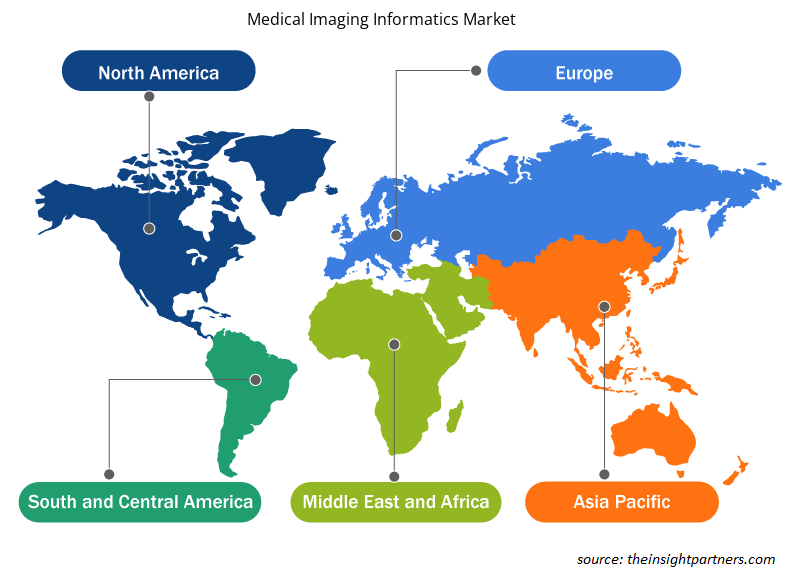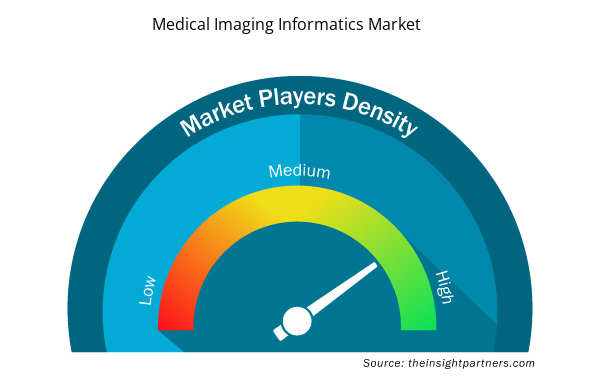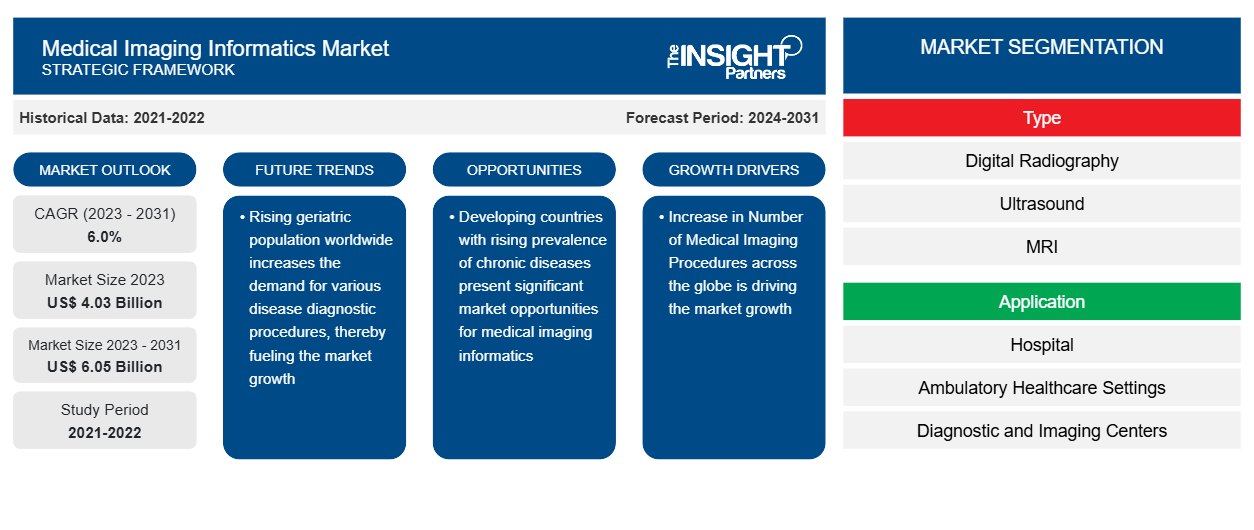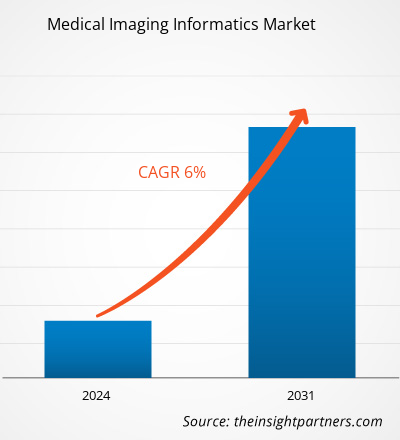医療画像情報科学の市場規模は、2023年の40億3,000万米ドルから2031年には60億5,000万米ドルに達すると予測されています。市場は2023年から2031年の間に6.0%のCAGRを記録すると予想されています。AI およびクラウドベースのプラットフォームに対する需要の高まりは、今後も市場の主要なトレンドであり続けると思われます。
医療画像情報科学市場分析
市場の成長を牽引する主な要因は、医療用画像診断処置の増加と高齢者人口の急増です。さらに、医療用画像情報科学の技術的進歩により、今後の予測期間中に市場の成長機会が生まれています。
医療画像情報科学市場の概要
臨床検索エンジン Radiology Key によると、画像情報科学では、情報技術 (IT) を使用して、医療ネットワーク内で効率的で正確かつ信頼性の高い医療画像サービスを提供します。放射線情報科学とも呼ばれる医療画像情報科学は、画像関連の情報とデータの保存、管理、およびアクセスを担当します。医療画像は、医療分野では特に心臓病学、産科、外科、婦人科のアプリケーションで広く使用されています。診断の増加に加えて、全体的な医療費を削減するために病状の早期診断を重視する地方政府や国家政府の高まりにより、世界中で磁気共鳴画像 (MRI)、コンピューター断層撮影 (CT)、超音波、X 線スキャンを受ける患者の数が増加しており、医療画像情報科学のニーズが高まっています。
要件に合わせてレポートをカスタマイズする
このレポートの一部、国レベルの分析、Excelデータパックなど、あらゆるレポートを無料でカスタマイズできます。また、スタートアップや大学向けのお得なオファーや割引もご利用いただけます。
- このレポートの主要な市場動向を入手してください。この無料サンプルには、市場動向から見積もりや予測に至るまでのデータ分析が含まれます。
医療画像情報市場の推進要因と機会
高齢者人口の急増
英国、カナダ、日本、中国、インド、韓国などの経済圏では、医療施設やサービスが大幅に近代化されています。その結果、これらの国の人々の平均寿命が延び、高齢者人口の増加につながっています。WHOのデータによると、2019年の60歳以上の人口は10億人で、2030年までに14億人、2050年までに21億人に増加すると見込まれています。高齢者層は主に、加齢に伴う心血管系の構造的・機能的変化により、心血管疾患(CVD)などのさまざまな慢性疾患に苦しんでいます。加齢は心臓や血管の硬化につながります。そのため、不整脈、冠動脈疾患、心不全は、75歳以上の人々によく見られるリスク要因です。アメリカ心臓協会(AAH)による2019年の心臓病と脳卒中の統計更新では、CVDの発生率は60〜79歳の男性で77.2%、女性で78.2%でした。さらに、CVDの発生率は80歳以上の成人男性で89.3%、成人女性で91.8%でした。このように、世界中の高齢者人口の増加により、さまざまな病気の診断手順と医療画像情報学の需要が高まり、市場の成長を後押ししています。
中国とインドのダイナミックなヘルスケア環境
中国やインドなどの発展途上国は、医療用画像情報科学にとって大きな市場機会を提供しています。人口増加、医療費の増加、慢性疾患の蔓延により、これらの国では高度な医療用画像技術に対する需要が高まっています。効率的なデータ管理、診断精度の向上、患者ケアの強化の必要性から、中国とインドではデジタル画像システムと情報科学ソリューションの採用が増加しています。中国では、医療インフラを近代化し、質の高い医療サービスへのアクセスを改善する政府の取り組みにより、医療用画像情報科学ソリューションの採用が増加しています。同国の人口の多さと医療部門の拡大により、高度な画像情報科学技術を提供するベンダーにとって巨大な市場が生まれています。インドでは、医療施設の数が増え、デジタル画像の利点に対する認識が高まっていることから、ワークフローを合理化し、臨床上の意思決定を強化できる情報科学ソリューションの需要が高まっています。これらの機会を活用し、これらの市場の特定のニーズに対応することで、ベンダーはこれらの発展途上国が提供する大きな成長の可能性を活用できます。
医療画像情報科学市場レポートのセグメンテーション分析
医療画像情報科学市場分析の導出に貢献した主要なセグメントは、製品とエンドユーザーです。
- タイプ別では、医療画像情報市場はデジタル放射線撮影、超音波、MRI、CT、核医学検査、マンモグラフィー。超音波部門は2023年に最大の市場シェアを占めました。
- アプリケーションに基づいて、医療画像情報科学市場は、病院、外来医療環境、診断および画像センター、その他に分類されます。病院セグメントは、2023年に最大の市場シェアを占めました。
- コンポーネントに基づいて、医療画像情報科学市場はソフトウェア、ハードウェア、サービスによって分割されています。ソフトウェアセグメントは2023年に最大の市場シェアを占めました。
医療画像情報科学の地域別市場シェア分析
医療画像情報科学市場レポートの地理的範囲は、主に北米、アジア太平洋、ヨーロッパ、中東およびアフリカ、南米および中米の 5 つの地域に分かれています。
北米では、米国が医療画像情報科学の最大の市場です。米国の医療画像情報科学市場は、がんの罹患率の増加、診断用画像に対する需要の高まり、および全国的な高齢者人口の増加により、大幅に成長すると予想されています。さらに、国内の大手市場プレーヤーによるさまざまな開発や、医療機器産業を促進するための政府投資の増加も、予測期間中の市場成長を促進すると予想されています。
米国および世界中で、がんは社会に大きな影響を与えています。がんの統計は、大規模な集団で何が起こっているかを示し、時間の経過とともに病気が社会に与える影響のスナップショットを提供します。Globocan 2020によると、米国では2,281,658件の新規がん症例があり、612,390人が死亡しました。米国で最も一般的ながんの種類は、乳がん、肺がん、前立腺がん、大腸がんなどです。したがって、米国でのがんの有病率の上昇により、超音波、MRI、デジタルおよびコンピューター放射線撮影などの医療用画像ツールの需要が高まると予想されます。医療情報インフォマティクスの需要も予測期間中に活況を呈するでしょう。
医療画像情報市場の地域別洞察
予測期間を通じて医療画像情報科学市場に影響を与える地域的な傾向と要因は、Insight Partners のアナリストによって徹底的に説明されています。このセクションでは、北米、ヨーロッパ、アジア太平洋、中東およびアフリカ、南米および中米にわたる医療画像情報科学市場のセグメントと地理についても説明します。

- 医療画像情報市場の地域別データを入手
医療画像情報科学市場レポートの範囲
| レポート属性 | 詳細 |
|---|---|
| 2023年の市場規模 | 40.3億米ドル |
| 2031年までの市場規模 | 60.5億米ドル |
| 世界のCAGR(2023年~2031年) | 6.0% |
| 履歴データ | 2021-2022 |
| 予測期間 | 2024-2031 |
| 対象セグメント | タイプ別
|
| 対象地域と国 | 北米
|
| 市場リーダーと主要企業プロフィール |
|
医療画像情報科学市場のプレーヤー密度:ビジネスダイナミクスへの影響を理解する
医療画像情報市場は、消費者の嗜好の変化、技術の進歩、製品の利点に対する認識の高まりなどの要因により、エンドユーザーの需要が高まり、急速に成長しています。需要が高まるにつれて、企業は提供内容を拡大し、消費者のニーズを満たすために革新し、新たなトレンドを活用し、市場の成長をさらに促進しています。
市場プレーヤー密度とは、特定の市場または業界内で活動している企業または会社の分布を指します。これは、特定の市場スペースに、その規模または総市場価値と比較して、どれだけの競合相手 (市場プレーヤー) が存在するかを示します。
医療画像情報市場で事業を展開している主要企業は次のとおりです。
- アグファ・ゲバルトグループ
- ケアストリームヘルス
- エサオテ スパ
- ゼネラル・エレクトリック
- フィリップスNV
- シーメンスヘルスケア株式会社
免責事項:上記の企業は、特定の順序でランク付けされていません。

- 医療画像情報市場のトップキープレーヤーの概要を入手
医療画像情報科学市場のニュースと最近の動向
医療画像情報科学市場は、主要な企業出版物、協会データ、データベースなど、一次調査および二次調査後の定性的および定量的データを収集することによって評価されます。医療画像情報科学市場におけるいくつかの開発を以下に示します。
- フィリップスは、RSNA で放射線科ワークフローのあらゆるステップでインテリジェンスを活用して診断の信頼性を高める新しい AI 強化インフォマティクス ソリューションを発表しました (出典: フィリップス、企業 Web サイト、2022 年 11 月)
医療画像情報市場レポートの対象範囲と成果物
「医療画像情報科学市場の規模と予測(2021〜2031年)」レポートでは、以下の分野をカバーする市場の詳細な分析を提供しています。
- 医療画像情報科学市場の規模と予測、および対象範囲に含まれるすべての主要市場セグメントの世界、地域、国レベルでの予測
- 医療画像情報科学市場の動向、推進要因、制約、主要な機会などの市場動向
- 詳細なPEST/ポーターの5つの力とSWOT分析
- 主要な市場動向、世界および地域の枠組み、主要プレーヤー、規制、最近の市場動向を網羅した医療画像情報科学市場分析。
- 市場集中、ヒートマップ分析、主要プレーヤー、医療画像情報市場の最近の動向を網羅した業界展望と競争分析
- 詳細な企業プロフィール
- 過去2年間の分析、基準年、CAGRによる予測(7年間)
- PEST分析とSWOT分析
- 市場規模価値/数量 - 世界、地域、国
- 業界と競争環境
- Excel データセット


- Visualization and 3D Rendering Software Market
- Fixed-Base Operator Market
- Pharmacovigilance and Drug Safety Software Market
- Nuclear Decommissioning Services Market
- UV Curing System Market
- Vision Guided Robotics Software Market
- Photo Editing Software Market
- Mesotherapy Market
- Semiconductor Metrology and Inspection Market
- Molecular Diagnostics Market

Report Coverage
Revenue forecast, Company Analysis, Industry landscape, Growth factors, and Trends

Segment Covered
This text is related
to segments covered.

Regional Scope
North America, Europe, Asia Pacific, Middle East & Africa, South & Central America

Country Scope
This text is related
to country scope.
よくある質問
North America dominated the medical imaging informatics market in 2023
Key factors driving market growth are the increasing number of medical imaging procedures and the surge in the geriatric population. However, the lack of expertise in operating medical imaging informatics systems is expected to restrict market growth during the forecast period.
Rising demand for AI- and cloud-based platforms will likely remain a key trend in the market.
Agfa-Gevaert Group, Carestream Health, ESAOTE SPA, General Electric, Koninklijke Philips N.V., Siemens Healthcare GmbH, Hologic, Inc., Konica Minolta, Inc., Shenzen Mindray Bio-Medical Electronics Co., Ltd., Fujifilm Holdings Corporation.
The market is expected to register a CAGR of 6.0% during 2023–2031.
Trends and growth analysis reports related to Technology, Media and Telecommunications : READ MORE..
The Insight Partners performs research in 4 major stages: Data Collection & Secondary Research, Primary Research, Data Analysis and Data Triangulation & Final Review.
- Data Collection and Secondary Research:
As a market research and consulting firm operating from a decade, we have published and advised several client across the globe. First step for any study will start with an assessment of currently available data and insights from existing reports. Further, historical and current market information is collected from Investor Presentations, Annual Reports, SEC Filings, etc., and other information related to company’s performance and market positioning are gathered from Paid Databases (Factiva, Hoovers, and Reuters) and various other publications available in public domain.
Several associations trade associates, technical forums, institutes, societies and organization are accessed to gain technical as well as market related insights through their publications such as research papers, blogs and press releases related to the studies are referred to get cues about the market. Further, white papers, journals, magazines, and other news articles published in last 3 years are scrutinized and analyzed to understand the current market trends.
- Primary Research:
The primarily interview analysis comprise of data obtained from industry participants interview and answers to survey questions gathered by in-house primary team.
For primary research, interviews are conducted with industry experts/CEOs/Marketing Managers/VPs/Subject Matter Experts from both demand and supply side to get a 360-degree view of the market. The primary team conducts several interviews based on the complexity of the markets to understand the various market trends and dynamics which makes research more credible and precise.
A typical research interview fulfils the following functions:
- Provides first-hand information on the market size, market trends, growth trends, competitive landscape, and outlook
- Validates and strengthens in-house secondary research findings
- Develops the analysis team’s expertise and market understanding
Primary research involves email interactions and telephone interviews for each market, category, segment, and sub-segment across geographies. The participants who typically take part in such a process include, but are not limited to:
- Industry participants: VPs, business development managers, market intelligence managers and national sales managers
- Outside experts: Valuation experts, research analysts and key opinion leaders specializing in the electronics and semiconductor industry.
Below is the breakup of our primary respondents by company, designation, and region:

Once we receive the confirmation from primary research sources or primary respondents, we finalize the base year market estimation and forecast the data as per the macroeconomic and microeconomic factors assessed during data collection.
- Data Analysis:
Once data is validated through both secondary as well as primary respondents, we finalize the market estimations by hypothesis formulation and factor analysis at regional and country level.
- Macro-Economic Factor Analysis:
We analyse macroeconomic indicators such the gross domestic product (GDP), increase in the demand for goods and services across industries, technological advancement, regional economic growth, governmental policies, the influence of COVID-19, PEST analysis, and other aspects. This analysis aids in setting benchmarks for various nations/regions and approximating market splits. Additionally, the general trend of the aforementioned components aid in determining the market's development possibilities.
- Country Level Data:
Various factors that are especially aligned to the country are taken into account to determine the market size for a certain area and country, including the presence of vendors, such as headquarters and offices, the country's GDP, demand patterns, and industry growth. To comprehend the market dynamics for the nation, a number of growth variables, inhibitors, application areas, and current market trends are researched. The aforementioned elements aid in determining the country's overall market's growth potential.
- Company Profile:
The “Table of Contents” is formulated by listing and analyzing more than 25 - 30 companies operating in the market ecosystem across geographies. However, we profile only 10 companies as a standard practice in our syndicate reports. These 10 companies comprise leading, emerging, and regional players. Nonetheless, our analysis is not restricted to the 10 listed companies, we also analyze other companies present in the market to develop a holistic view and understand the prevailing trends. The “Company Profiles” section in the report covers key facts, business description, products & services, financial information, SWOT analysis, and key developments. The financial information presented is extracted from the annual reports and official documents of the publicly listed companies. Upon collecting the information for the sections of respective companies, we verify them via various primary sources and then compile the data in respective company profiles. The company level information helps us in deriving the base number as well as in forecasting the market size.
- Developing Base Number:
Aggregation of sales statistics (2020-2022) and macro-economic factor, and other secondary and primary research insights are utilized to arrive at base number and related market shares for 2022. The data gaps are identified in this step and relevant market data is analyzed, collected from paid primary interviews or databases. On finalizing the base year market size, forecasts are developed on the basis of macro-economic, industry and market growth factors and company level analysis.
- Data Triangulation and Final Review:
The market findings and base year market size calculations are validated from supply as well as demand side. Demand side validations are based on macro-economic factor analysis and benchmarks for respective regions and countries. In case of supply side validations, revenues of major companies are estimated (in case not available) based on industry benchmark, approximate number of employees, product portfolio, and primary interviews revenues are gathered. Further revenue from target product/service segment is assessed to avoid overshooting of market statistics. In case of heavy deviations between supply and demand side values, all thes steps are repeated to achieve synchronization.
We follow an iterative model, wherein we share our research findings with Subject Matter Experts (SME’s) and Key Opinion Leaders (KOLs) until consensus view of the market is not formulated – this model negates any drastic deviation in the opinions of experts. Only validated and universally acceptable research findings are quoted in our reports.
We have important check points that we use to validate our research findings – which we call – data triangulation, where we validate the information, we generate from secondary sources with primary interviews and then we re-validate with our internal data bases and Subject matter experts. This comprehensive model enables us to deliver high quality, reliable data in shortest possible time.


 このレポートの無料サンプルを入手する
このレポートの無料サンプルを入手する